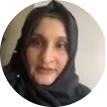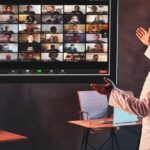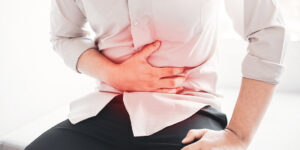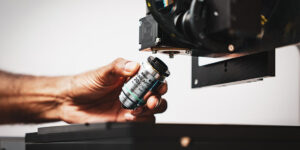In Pakistan, many more cancer patients could benefit from intraoperative consultations. However, there is still work to be done. We spoke to dr. Ali on the situation in her home country.
Up to 40 minutes: This is the time it takes for the axillary lymph node surgical specimen to reach the pathology department in Karachi’s leading national hospital in the heart of the Pakistani city. In another hospital, a breast cancer patient is lying under anesthesia and the surgeon is waiting for the intraoperative pathology report to proceed with the surgery.
Dr. Rabia Ali is consultant histopathologist and assistant professor at the Liquiat National Hospital in Karachi, one of the leading medical care centers in the country and the largest breast cancer center in the region. Together with her team, Dr. Ali will review the lymph node specimen within the 20 minutes prescribed by the protocol for intraoperative consultations. The specimen is first examined with the bare eyes. It is weighed, measured and assessed before it is dissected to prepare one or more frozen sections for microscopic assessment. This will show whether the lymph nodes carry metastases or not. This information is critical for surgery and relayed immediately to the operating surgeon, who can proceed accordingly with the surgery.
With over 225 million inhabitants, Pakistan is the fifth most densely populated country in the world. As much as 75% of the population lives in rural areas and do not have access to this kind of surgical pathology service. In the region, there are only very few hospitals to offer this type of intraoperative services. The national hospital in Karachi is one of them. Its pathology department receives inhouse surgical specimens and requests from other hospitals in the city.
This is the background of my recent discussion with Dr. Rabia Ali about the state of intraoperative consultations in Pakistan. I wanted to find out what the challenges are and what opportunities could be generated in the region through the digitization of intraoperative pathology.
Stay Ahead with Insights from Precipoint!
Welcome to our newsletter! Be the first to know about our latest products, services, webinars, and happenings in PreciPoint. Don't miss out on this opportunity to stay informed. Subscribe to our newsletter today!
By clicking “Subscribe”, you agree to our privacy policy.
Dr. Ali, what kind of surgical specimen do you see the most?
The hospital I work in is the largest breast cancer center in the region. Most specimen we get for frozen section are axillary lymph nodes prior to chemotherapy. The intraoperative question here is whether the lymph nodes are positive or negative for metastases. Of course, the objective is to avoid the surgical clearance of the lymph nodes because it is a very heavy surgery.
We also see a lot of ENT-specimens because oral cancer is very common in this part of the world. These are whole mandible or maxillary dissection specimens for surgical clearance. Ovarian masses are also very common because pre-surgical biopsies are not possible. Besides, we also get rectal biopsies for presence of absence of ganglion cells, brain tumor biopsies for diagnosis and adequacy and mediastinal masses biopsies for adequacy.
What do you actually do when a frozen section comes in?
We receive in-house specimens from our own operating theater (OT) department and consultations from the other hospitals in the city. Together with our resident doctor, we evaluate the gross specimen. We decide how to dissect it and which dissections we will examine. Then, a technician freezes the dissection to -20 to 30o C, then they use a microtome to slice it very thinly, as thin as 2 micrometers. Finally, they stain the tissue section and mount it onto a glass slide. The doctor and I review the section under the microscope and report our findings to the surgeon. All of this has to be done within 20 minutes per section. This is the protocol. For large specimen like whole cheeks, we sometimes do 5 or 6 sections. This takes more time, sometimes up to 45 minutes.
How long does it take for the specimen to reach you from other hospitals?
Karachi is a very large city, but we are located in the very center. Usually, it takes 35 to 40 minutes for a specimen to reach us from another hospital in the city. This is a very long time when the patient is lying under anesthesia. We don’t receive specimen from other cities or from the remote areas. Practically speaking, this is not possible.
What are the main 3 challenges for intraoperative consultations in your country?
Our country is one of the most densely populated country in the world, but we have few big cities. There are hospitals throughout the country. There are surgeons there doing surgery every single day. But the pathologists are not there, the technicians are not there, the labs are not there. There is no modern technology to help us do our work. And the problem is that we cannot train so many people.
So, to answer your question, our problem number one is the number of pathologists. There aren’t enough of them. And from those who are there, very few are comfortable with frozen section.
Then, we also do not have enough trained technicians to deal with frozen section. You need expert technicians who know how to handle a very fresh specimen. You cannot afford to waste it.
Finally, surgeons throughout the country must realize that what capabilities we have. There are surgeons who do not know that there are pathologist services available. They just don’t know it in the first place. This is mainly because they are far remote and do not have access to the information.

In our country, we cannot have more centers, more pathologists, more technicians. We cannot train them all and pay them all. But we can have digital slides. We can work with digital slides, as long as they have a very high resolution.
Dr. Rabia Ali
What could be done to improve the number of consultations in Pakistan, ultimately improving treatment plans for cancer patients across the country?
If you want to increase the number of consultations, the first answer that comes to mind would be to have more centers and more pathologists. But practically speaking, this is not possible. In our country, we cannot have more centers, more pathologists, more technicians. We cannot train them all and pay them all.
But we can have images. We can look at digital images and work on them, as long as they have a very high resolution. If we can magnify the microscopy images multiple times, then that can be of a real help.
Digitalization sounds very difficult to implement, but it is the need of the hour. We need tools that can be set up in remote areas. We could use modern technology in the remote places to transfer microscopy images of the frozen section to us in the city. This kind of remote assessment would work very well for single tissue, like for example rectal tissue for ganglion biopsy, or for very small specimen where we only have one frozen section block.
Is remote assessment the solution, or are there other considerations?
I think that for large samples requiring multiple blocks, digitization would have its limitations here.
Importance of Personal Assessment in Gross Specimen Examination
Let’s take an ovarian mass for example. I see the gross specimen myself. I measure it, weigh it, see the integrity. All this will have an impact on the tumor staging. I also decide which sections to take.
Now, if someone sitting 500 miles away from me has to do this work for me, then I do not know what this person has seen.
Need for Trained Technicians in Remote Locations
I would also like to add that in a digital setup, where the surgeon is sitting in a remote hospital and the pathologist is in his office in the city, you still need a trained technician in the remote place to prepare the section.
Training Remote Technicians as Part of the Solution
For me, while digitization can bridge the gap between the surgeon and the pathologist, the little gap where the technician fits in would still need to be covered. Training remote technicians is part of the solution.
In my department, we are a big setup. There are over 20 technicians but only 5 to 6 can do the frozen section cutting. They have 15 to 20 years’ experience and are amazing at it, but not everybody can do that. So, we have implemented a training program for technicians from remote areas. We bring them to the cities and train them. If you want to make a change, this is what needs to happen.
Rabia Ali, thank you for taking the time to answer our questions.











